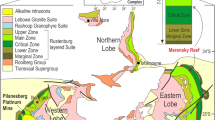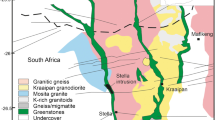Summary
The Sompujärvi (SJ) PGE Reef is located at the border between the third and fourth megacyclic units, 400–1000 metres above the base of the Penikat layered intrusion. It usually occurs in the basal bronzititic portion of megacyclic unit IV, but can occur in the overlying peridotitic cumulates or the gabbroic cumulates at the top of megacyclic unit III in places. PGE concentrations have been found to occur mainly in association with either base metal sulphide (mainly pyrite-chalcopyrite-pentlandite) or chromite disseminations, the latter type usually representing a distinctly higher grade of mineralisation.
When the magma which formed megacyclic unit IV penetrated into the Penikat layered intrusion, its lower part intermixed with the older residual magma. It may be assumed that this mixing of magmas was responsible for the precipitation and PGE enrichment of sulphides in the lower part of the olivine cumulates, accounting for the sulphide-disseminated mineralization type. The entry of the new magma pulse was probably quite powerful, and when this magma spread out over the uppermost, partly consolidated gabbroic cumulate of megacyclic unit III it caused pronounced local erosion in the uppermost crystal layer and excavated elongated channels and/or depressions, as associated with faulting. These channels and depressions then trapped older residual liquid enriched in platinum-group elements and the chromite-disseminated type within the SJ Reef was formed.
Zusammenfassung
Das Sompujärvi (SJ) PGE Reef liegt im Grenzbereich von Megazyklus III und IV, 400 1000 m oberhalb der Basis der Penikat Intrusion.
Normalerweise tritt es in den liegenden Bronzititen des Megazyklus IV auf; es kann aber sehr wohl auch in den peridotitischen und gabbroiden Kumulaten in den obersten Teilen von Megazyklus 111 entwickelt sein. PGE Anreicherungen sind entweder an Sulfide (hauptsächlich Pyrit-Kupferkies-Pentlandit) oder an disseminierten Chromit geknüpft. Der letztere Vererzungstyp ist durch höhere Gehalte gekennzeichnet.
Während der Intrusion der Magmen des Megazyklus IV kam es zu einer Magmenmischung zwischen diesen und älteren Magmen. Es kann angenommen werden, daß dieses “magma-mixing” für die Ausfällung und Anreicherung der PGE's in den Sulfiden, die in den tieferen Anteilen der Olivin-Kumulate auftreten, verantwortlich zu machen ist und der Grund für diese disseminierte an Sulfide gebundene Vererzung ist. Das Eindirngen mächtiger neuer Magmenschübe und die Ausbreitung dieses Magmas über die obersten, bereits konsolidierten Gabbro-Kumulate des Megazyklus III, verursachten eine lokal intensive Erosion in diesen obersten bereits kristallisierten Lagen. Längliche Spaltensysteme und/oder Einsenkungen, ähnlich wie bei Störungen, wurden angelegt. In diesen Spaltensystemen und Einsenkungen sammelte sich ältere Schmelze, die an Elementen der Platingruppe angereichert war. Sie bildete die an disseminierten Chromit gebundene Vererzung im SJ Reef.
Similar content being viewed by others
References
Alapieti TT, Filèn BA, Lahtinen JJ, Lavrov MM, Smolkin VF, Voitsekhovsky SN (1990) Early Proterozoic layered intrusions in the northeastern part of the Fennoscandian Shield. This volume, pp 1–22
——Lahtinen J (1986) Stratigraphy, petrology, and platinum-group element mineralization of the early Proterozoic Penikat layered intrusion, northern Finland. Econ Geol 81: 1126–1136
—— (1989) Early Proterozoic layered intrusions in the northeastern part of the Fennoscandian shield. In:Alapieti T (ed) 5th International Platinum Symposium. Guide to the post-symposium field trip, August 4–11, 1989. Geol Surv Finland. Guide 29: 3–41
— Sivonen SJ (1983) Use of the electron microprobe in the investigation of the early Proterozoic Koillismaa layered igneous complex, NE Finland. Geol Surv Finland, Rep Invest 61
Ballhaus CG, Stumpfl EF (1985) Occurrence and petrological significance of graphite in the Upper Critical zone, western Bushveld South Africa. Earth Planet Sci Letters 74: 58–68
—— —— ——(1986) Sulfide and platinum mineralization in the Merensky Reef: evidence from hydrous silicates and fluid inclusions. Contrib Mineral Petrol 94: 103–204
——Cornelius M, Stumpfl EF (1988) The Upper Critical Zone of the Bushveld Complex and the origin of Merensky-type ores—A discussion. Econ Geol 83: 1082–1085
Barnes S-J, Boyd R, Korneliussen A, Nilsson L-P, Often M, Pedersen RB, Robins B (l988) The use of mande normalization and metal ratios in discriminating between the effects of partial melting, crystal fractionation and sulphide segregation on platinum-group elements, gold, nickel and copper: examples from Norway. In:Prichard HM, Potts PJ, Bowles JFw, Cripp SJ (eds) Geoplatinum. Elsevier, London pp113–143
—— ——Naldrett AJ, Gorton MP (1985) The origin of the fractionation of platinum-group elements in terrestrial magmas. Chem Geol 53: 303–323
Boudreau AE (1988) Investigations of the Stillwater Complex. IV. The role of volatiles in the petrogenesis of the J-M Reef, Minneapolis Adit section. Can Mineral 26: l93–208
——Mathez EA, McCallum IS (1986) Halogen geochemistry of the Stillwater and Bushveld Complexes: evidence for transport of the platinum-group elements by Cl-rich fluids. J Petrol 27: 967–086
Cabri LC, Rosenzweig A, Pinch WW (1977) Platinum-group minerals from Onverwacht. I. Pt-Fe-Cu-Ni alloys. Can Mineral 15: 380–384
Campbell IH, Naldrett Al Barnes SJ (1983) A model for the origin of the platinum-rich sulfide horizons in the Bushveld and Stillwater Complexes. J Petrol 24: 133–165
Halkoaho TAA, Alapieti TT, Lahtinen JJ (1989) The Sompujärvi PGE mineralization in the Penikat layered intrusion, northern Finland. In:Alapieti T (ed) 5th International Platinum Symposium. Guide to the post-symposium field trip, August 4–11, 1989. Geol Surv Finland. Guide 29: 71–92
———Lerssi JM (1990) The Ala-Penikka PGE Reefs in the Penikat layered intrusion, northern Finland. This volume, pp 23–37
Huhtelin TA, ALapieti TT, Lahtinen JJ (1989) Megacyclic units l, D and III in the Penikat layered intrusion. In:Alapieti T (ed) 5th International Platinum Symposium. Guide to the post-symposium field trip, August 4–11, 1989. Geol Surv Finland. Guide 29: 59–69
—————(1990) The Paasivaara PGE Reef in the Penikat layered intrusion, northern Finland. This volume, pp 57–70
Irvine TN, Keith BW, Todd SG (1983) The J-M platinum-palladium Reef of the Stillwater Complex, Montana: II. Origin by double-diffusive convective magma mixing and impli-cations for the Bushveld Complex. Econ Geol 78: 1287–1334
Le Maitre RW (1976) Some problems of Be projection of chemical data into mineralogigal classifications. Contrib Mineral Petrol 56: 181–189
Mathez EA, Dietrich VJ, Holloway JR, Boudreau AE (1989) Carbon distribution in the Stillwater Complex and evolution of vapor during crystallization of Stillwater and Bushveld magmas. J Petrol 30: 153–173
Mclaren CH, De Villiers JPR (1982) The platinum-group chemistry and mineralogy of the UG-2 chromitite layer of the Bushveld Complex. Econ Geol 77: 1348–1366
Naldrett AJ (1981) Platinum-Group element deposits. In:Cabri LJ (ed) Platinum-group elements: mineralogy, geology, recovery, Montreal. Canadian Institute of Mining and Metallurgy: 197–231 (CIM Spec. vol. 23).
—— —Cabri LJ (1976) Ultramafic and related mafic rocks: their classification and genesis with special reference to the concentration of nickel sulfides and platinum-group elements. Econ Geol 71: 1131–1158
Stumpfl EF, Rucklidge JC (1982) The platiniferous dunite pipes of the eastern Bushveld. Econ Geol 77: 1419–1431
Sun, S-S (1982) Chemical composition and origin of the earth's primitive mantle. Geochim et Cosmochim Acta 16: 179–192
Volborth AA, Housley RM (1984) A preliminary description of complex graphite, sulphide, arsenide, and platinum group element mineralization in a pegmatoid pyroxenite of the Stillwater Complex, Montana, U.S.A. Tschermaks Miner Petrogr Mitt 33: 213–230
Von Gruenewaldt G (1979) A review of recent concepts of the Bushveld Complex with particular reference to sulfide mineralization. Can Mineral 17: 233–256
Author information
Authors and Affiliations
Additional information
With 8 Figures
Rights and permissions
About this article
Cite this article
Halkoaho, T.A.A., Alapieti, T.T. & Lahtinen, J.J. The Sompujärvi PGE reef in the Penikat layered intrusion, northern Finland. Mineralogy and Petrology 42, 39–55 (1990). https://doi.org/10.1007/BF01162683
Received:
Accepted:
Issue Date:
DOI: https://doi.org/10.1007/BF01162683




